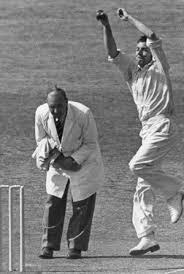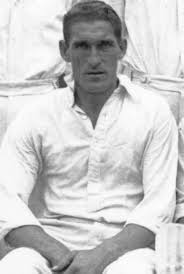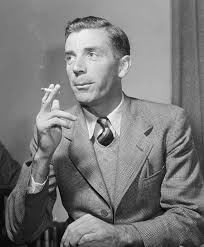I have played cricket at school, club and village level for over fifty years, and have fooled hundreds of batsmen into giving up their wickets to my own peculiar brand of left arm filth. However, in all that time and all those games, I have only once taken a hat-trick, and that was for the Fathers XI against Dover College Prep School first XI sometime in the 1980s. Three twelve year olds in successive balls (bowled, stumped, caught, if you want to know) is not an achievement I ought really to be proud of. But it has shown me how very difficult it is to take three wickets in consecutive balls, and it makes me even more admiring of those who have achieved the feat. I bow low before the magnificent Dean Headley – three hat-tricks in one season in 1996 – but the man who leaves me completely awestruck is the only man in the history of the game to have taken seven first-class hat-tricks, Doug Wright.

D.V.P. Wright in his delivery stride
Doug Wright is, of course, a Kent legend. He took 1709 wickets for Kent in a career stretching over 397 games from 1932 to 1956; he was captain of the county in his final three seasons; he took 100 wickets in a season 9 times and also had time to fit in 34 Tests for England. After his retirement, he became a much respected coach and I remember him well into his seventies, still bowling his fizzing leg-breaks at young hopefuls in the Ames-Levett Centre.
Of his seven hat-tricks, six were in county championship games and one was for MCC when touring in South Africa in the winter of 1938/39. All, by coincidence, were taken in the opposition’s first innings, and in those seven innings, he had a combined analysis of 45 wickets for 365 runs. His first hat trick was against Worcestershire at Worcester on 3 July 1937. His three victims were Messrs. J. Horton, B.W. Quaife and the wonderfully named Harold Harry Ian Haywood Gibbons. Quite why Gibbons’ Mum and Dad christened him both Harold and Harry I am not sure, but Wright clearly was not bothered by this nominal anomaly, and went on to take 7 for 27 as Kent trampled over Worcestershire by an innings and 110 runs.
Doug Wright’s second hat-trick was against Nottinghamshire at Trent Bridge at the end of the same month, July 1937. The match ended in a draw, but in dismissing Notts for 190 in their first innings, Wright took 6 for 47, including the wickets of two Joes, Knowles and Hardstaff, and a George, G.V. Gunn, in the space of three balls. Of the Notts’ total of 190, their opener Walter Keeton carried his bat for 99*, with the last man, debutant Dennis Watkin, run out for a duck. I can imagine their dressing room chat between innings.
Hat-trick number three was against Gloucestershire at Gillingham on 18 May 1938, the first day of a match that Gloucestershire won by 169 runs. Wright dismissed Reg Sinfield, Bill Haynes and Monty Cranfield with successive balls on his way to 7 for 77. His fourth hat-trick for the county was also against Gloucestershire the following season, this time at Bristol and the match resulted once again in defeat for Kent. This was a remarkable game by any standards, and for once Wright’s hat-trick was not the outstanding feature of the game. Gloucestershire batted first, and made 284, of which Wally Hammond made 153 not out, and Wright took 9 for 47 in 21.5 overs, his best ever first-class analysis. His hat-trick victims were Bill Haynes (again), George Lambert and Tom Goddard, all clean bowled. Goddard, however, quickly had his revenge. Kent were soon all out for 120 (Wright, b Goddard 0) with Tom Goddard upstaging Wright by taking 9 for 38, but without a hat-trick. In their second innings, following on, Kent collapsed to 124 all out (Wright, st Wilson b Goddard 2), and Goddard finished with 8 for 68, helping the west country side to win by an innings and 40 runs. All 17 of Goddard’s wickets were taken on the second day, 3 July, to equal a record set by, among others, Charlie Blythe. Definitely Goddard’s match, not Wright’s.

Tom Goddard, Gloucestershire’s second most prolific wicket-taker
Between those two Gloucestershire hat-tricks, Doug Wright had been on tour with MCC to South Africa. On 13 January 1939, MCC played Border in East London, and Wright, bowling first change after only four overs of the match, accounted for Stanley White, Harold Whitfield and Dereck Dowling in successive balls. None of these men ever represented South Africa, so you could argue it was not the strongest batting line-up that Wright had ever faced, but in one way the hat-trick was unique. White and Whitfield both shared the middle name Lorraine and I can be fairly confident that, outside the women’s game, this is the only hat-trick featuring two victims called Lorraine. Tom Goddard, incidentally, was playing alongside Wright for MCC in this game, but only took one wicket as MCC eased to victory by nine wickets.
Doug Wright’s final two hat-tricks both came after the war. He lost six seasons, not to mention several possible overseas tours, to the conflict, so imagine how many hat-tricks he might have got if there had been first-class cricket all through his active career. At Hastings in August 1947, Wright finished off their hosts’ first innings by dismissing George Cox, John Nye (whose middle name was Kent) and Jim Cornford, caught Evans, caught Fagg and clean bowled. He finished with 7 for 54, and in Sussex’s second innings, without getting another hat-trick, he took 8 for 119 as Kent coasted to a nine-wicket win.
The last hat-trick of Doug Wright’s amazing career was in 1949, fittingly at Canterbury, against Hampshire. This was a game over in two days, with Kent victorious by an innings and 28 runs. Another Canterbury Week match over too soon for the club secretary’s liking. However, there were some 14,000 people there on the second day, among them the Duke of Edinburgh, to watch Wright get rid of Desmond Eagar, Cliff Walker (always likely to fall quickly with a name like that) and Derek Shackleton in successive balls. He took 5 for 81 in that innings, and followed it up with 6 for 89 in Hampshire’s second innings, bowling 48 overs in the day.
A hat-trick is always newsworthy. Nobody has managed it for Kent in a first-class match since James Tredwell did so against Yorkshire at Headingley in 2010. Joe Denly managed that amazing century and a hat-trick against Surrey at the Oval in the T20 in 2018, but while two wickets in two balls is pretty common, the hat-trick remains a rare feat. All the more reason to salute Douglas Vivian Parsons Wright, the king of the hat-trick.

Doug Wright, relaxing after a hard day in the field?
0 Comments